Menus
- Choose your category according to your level, tastes and budget
- Kawasaki Ninja 400, ZX-6R and ZX-10R circuit comparison
- An adapted route !
- 600 and a few cm3, the ideal displacement ?
- The 200 thoroughbred track !
- A question of budget more than of skills
- K Days
Choose your category according to your level, tastes and budget
Kawasaki Ninja 400, ZX-6R and ZX-10R circuit comparison
The temptation to go on the track to have fun without restraint and with much less risk than on the road is growing. But which frame to choose ? Which motorcycle is the best on the track? Is it better to have a small valiant than a large uncontrolled one? To get an idea, we carried out the comparison with three sports cars of different capacities, during a track day on the Le Mans circuit..
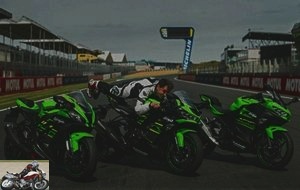 What motorcycle for the track ?
What motorcycle for the track ?
When you see the ease of champions on TV, it almost seems like it’s easy, but in real life, we’re not all MotoGP riders, far from it. So the ideal frame for them is not necessarily the one that suits us best. Small displacement agile, sharp supersport or superbike loaded with assistance? Let’s see what benefit a seasoned biker can derive from it.
"More power" Freddie Spencer always replied to HRC engineers when they asked him what he wanted to upgrade his 500 2 stroke. It was 1985 and it was developing around 140 hp! Today, if he tried a MotoGP that admits about twice that, he might not say the same thing…. But we are not all the same and riding a less powerful motorcycle, but more agile can also be a real source of pleasure when we are not a champion at heart, or quite simply prefer the small ones ….
 Small displacement, supersport or superbike? We will see…
Small displacement, supersport or superbike? We will see…
An adapted route !
Those who drive a little of everything will tell you: while driving a 125 you get a hell of a banana. Riding a small, light machine, you get the impression that anything goes and that you are passing the bends at breakneck speed. We brake late, we throw the bike without restraint and we open the throttle like a piglet. Pure pleasure, fun, provided the track is suitable.
With a modern 125 (15 hp), the go-kart track is arguably the best place to have fun. For our test, we were on the legendary Bugatti circuit and a 125 would not have had its place among the machines present. The climb to the Dunlop curve would have been hell. Already our benchmark small-displacement 400 Kawasaki Ninja was struggling a bit, yet it grabbed just over 180 km / h in full fifth before reaching the chicane. It’s very little in front of the 1000, but except at this precise place, where the speed difference is important, we feel perfectly safe on the little Kawa..
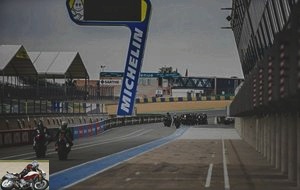 It is on the Bugatti circuit of Le Mans that we test the full extent of the sports range
It is on the Bugatti circuit of Le Mans that we test the full extent of the sports range
The single front disc does the job without slackening, because even if the beast only displays 168 kg full on the scale, its 45 hp does not take it to stratospheric speeds that would heat its brakes. (For the record, the kinetic energy to be dissipated is proportional to the mass, but above all to the square of the speed, so more than the kilos, it is the kilometers / hours that count). Low horsepower also means tires that are a bit narrower but don’t stall under acceleration. With a 110 front and a 150 rear, the Ninja 400 is well stocked, and the lack of electronic assistance, other than ABS, creates no angst or frustration. The little Twin climbs briskly up to 10,000 rpm in "raging silence". It won’t electrify the crowds, but it does the job well.
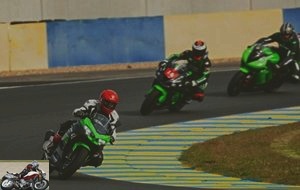 Small engines like the Ninja 400 are very easy to access
Small engines like the Ninja 400 are very easy to access
The sporty GT-style stance with straps above the handlebars is not tiring, while the chassis takes on the ponies without flinching. Thus, we can concentrate on pure piloting, without ulterior motives and seek the limits. On the handlebars, all things considered, we find the sensations of a 125, with a few pounds and extra horses, just enough to have fun. Even without being a pilot, you feel more dominant than dominated. We fine-tune our trajectories, our position, we delay our braking without apprehension, in short, we have fun like crazy…. But friends seriously dislocate you in the stretches. It’s not ridiculous in the twisty sections, but at Le Mans, 45 hp is a bit tight. Everyone should have the same bike, but except for riding in the "300" class, that’s not the case. So we can not really get away with the pals and it has a little frustrating side. However, it is worth remembering that a Moto3 of 80 kg and 55 hp at the wheel and a GP rider would qualify in the middle of the 1000 for the start of the 24 hours of Le Mans…. (lap record in 1.41.754!).
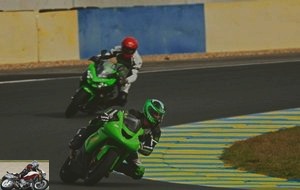 On the other hand, their moderate power remains a brake, especially if you ride with friends.
On the other hand, their moderate power remains a brake, especially if you ride with friends.
So a small displacement is a choice that remains relevant, especially since the category has been expanding for several years and now we are spoiled for choice: Honda CBR500R, KTM RC 390, Yamaha YZF-R3 are there. to make life hard for our little kawa on the circuits. In addition, in addition to a reasonable purchase and use price, these small machines are also less expensive in the event of a fall. Less gasoline, fewer tires and above all less expensive, here is a not stupid alternative for those who want to get their hands on and more if they like. Conclusion, the reason of the strongest is not always the best and we will demonstrate it later ….
600 and a few cm3, the ideal displacement ?
By going from the 300 category to the 600 and in particular from the twin to the 636 cm3 four-cylinder of the ZX-6R, we almost double the price (6,199 to 11,699 €), we almost triple the power (45 to 130 hp), for an increased weight of only 28 kg, with a much better weight / power ratio. In fact, we are changing universes. Even if the 636 cannot participate in Supersport events because of its additional 36 cm3, it claims a pure sporting lineage. Inverted fork, double front disc with radial calipers, 100% aluminum chassis (swinging arm and frame) adjustable quality suspensions, “up” shifter, traction control…., Etc. She has everything big and on her handlebars, we like to think of ourselves as a pilot.
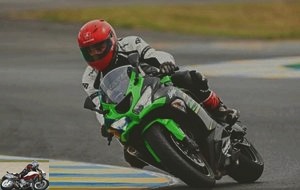 By passing on the ZX-6R we literally change category
By passing on the ZX-6R we literally change category
Precise, while remaining manoeuvrable, it has attractive mechanics, a little less sharp than the average of the 600 four cylinders because of its 6% greater displacement. Angry, it blithely exceeds 15,000 rpm and offers a good range of use. However, who will opt for this type of engine will have to play copiously with the selector to stay in the turns, under penalty of remaining stuck out of the turn. It is therefore important to have good trajectories and a smooth ride so as not to lose too much speed in the turns. Getting in at the right speed and in the right gear is a little game that requires skill.
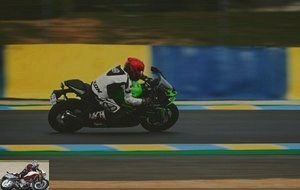 The 600s have the advantage of being also very manoeuvrable.
The 600s have the advantage of being also very manoeuvrable.
The 600 forgive less mistakes than the 1000. At this level, their piloting is more "fine". However, on exiting the turn, we do not wonder about the angle of rotation of the throttle to give. Traction control or not, we put it all in, without fear and without reproach. The high-side risks are moderate for an amateur rider. The 180 mm rear tire, standard in the category, offers an excellent level of performance and for those who do not have the original tires enough, we find authentic sports tires at all manufacturers in these sizes.
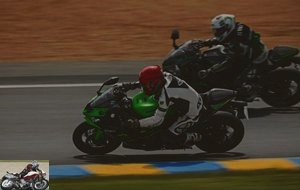 Supersports tend to forgive errors in judgment less
Supersports tend to forgive errors in judgment less
Compared to the 400, performance leaps forward and the gap with the 1000 is much smaller. On some circuits, the times are even very close. Suddenly the complexes are partly dissipated. By getting out of bends, we manage to deceive ourselves and make up all or part of our delay by pushing back our braking. There is hardly anything other than at the junction preceding the pit straight that one inevitably gets dropped off. The 600 and some, so that’s the happy medium for anyone who wants to get started. There are hardly any "details" and especially the braking that one manages to tickle the limits, even without being a handlebar virtuoso. The quality of the brakes is not that of a 1000 and it feels like a bit of slack when you apply them severely over several laps.
 However, we can accelerate wide open throttle with much less risk.
However, we can accelerate wide open throttle with much less risk.
Before riding the 1000, we tell ourselves that the 636 is the right intermediary. In addition, even if the Supersport category is now reduced to two models (the Yamaha YZF-R6 and the Kawasaki ZX-6R 636 which cannot be raced), there are many second-hand machines on the market. all kinds which are competitive on the track and cheap (Honda CBR600RR, Suzuki GSX-R 600). In addition, despite their mind-boggling engine speeds, these machines are known to be reliable. Suddenly from 2,000 €, we have a machine ready to run which brakes and which holds the road. This is a very serious option for those who have no other ambition than to have fun. With a higher budget, the choice becomes vast. There are also twin 748/749 or even 848 and triple 675 or 800. Finally, note that the ZX-6R 636 is an interesting alternative for those who do not want to buy a motorcycle that has already raced..
The 200 thoroughbred track !
200 horses and a few, nearly 22,000 €, for 208 kg with full tank, when it comes time to get on the ZX-10R, the pedigree is impressive. Do I have the skills to pilot such a machine, will I be thrown into the air on the first acceleration? Beyond the prestige of the 1000s and the Kawa in particular, one wonders about one’s own skills, especially when one thinks back to the 140 hp of Freddie Spencer’s motorcycle…. Is it really useful? The best way to find out is to carefully take a few laps on the track.
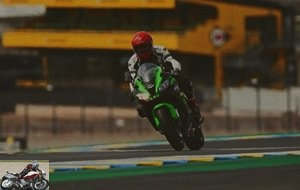 Superbikes like the Ninja ZX-10R are finally quite easy thanks to a more present torque.
Superbikes like the Ninja ZX-10R are finally quite easy thanks to a more present torque.
The size imposes a little more than the 636, but the difference in weight is not very noticeable. 10 kg, it hardly makes more than 5% of difference. What is more noticeable, however, is the much more present engine torque. Suddenly, the one that scared at the start ended up being more docile and easier to ride. A whole different universe there again, but which knows how to remain accessible. Sure these 200 thoroughbreds are well bred. You could be wrong with a gear when entering a turn, there is always what you need at the bottom of the tachometer to propel properly when exiting. It is when the needle climbs towards the red that we are more likely to be afraid. There it grows for good and you have to have your heart (or the rest) well hooked when entering the Dunlop curve. This time we arrive really quickly and even when upshifting, the acceleration remains vigorous at high speed..
Fortunately, the quality of the brakes and suspensions is up to the engine performance. The braking is powerful, progressive, controllable and enduring at the same time, with just the right amount of bite. Brembo M 50 calipers combined with 330mm floating discs provide as much as they reassure. Of course, you get through the bends faster, but you are more confident about the bike’s ability to slow down in order to enter at the speed you want, by precisely adjusting your braking. The quality of the suspensions is also in clear progress, even if the 636 was already well equipped. Here the pressurized front fork and rear shock absorber, both adjustable in compression / rebound, offer an even more delicate track feel. In fact, the ABS braking fully exploits the available grip and does not trigger.
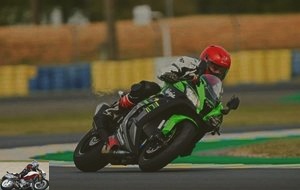 The richly equipped cycle part ensures total control
The richly equipped cycle part ensures total control
When accelerating, it’s the same thing. Electronic aids are seldom triggered for the common rider and when they do, it is gently, without scaring the rider. On board, everything is done to make your life easier. The "up and down" shifter is the perfect illustration of this. So, apart from the speeds reached which can be frightening at first, the 1000 is not more difficult to drive. She gives and forgives more at the same time. When we say that it gives, it is an image, since it is still worth almost twice the 636, or almost 4 times the price of the 400, more than four times less powerful it is true. You will also have to deal with more expensive tires that last less. But here, no problem to get away with the pals, they will not dump you in a straight line! There, you are spoiled for choice since the main European and Japanese manufacturers have their in-house superbikes with the Aprilia RSV4 1100 Factory, BMW S1000RR Ducati Panigale V4 S, Honda CBR1000RR Fireblade, Suzuki GSX-R 1000 R and other Yamaha YZFs -R1, not counting the old versions available on occasion.
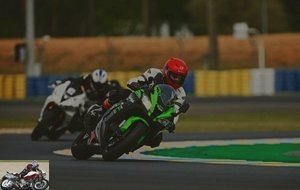 And when we miss each other, the many assistants are there to take over
And when we miss each other, the many assistants are there to take over
A question of budget more than of skills
In the end, we will have fun with the three machines, subject to a circuit and competition adapted with the Ninja 400. The strength of these machines is to know how to remain accessible from a pure point of view of piloting . For the budget, this is less true. But as they say the price is forgotten and the quality remains. Personally, I had a lot of fun with the 400, but I’m missing a little something to crack. The ZX-10R is a very pleasant find. I imagined her to be meaner, but she knows how to make herself accessible. After ten years or so on the circuits, my choice will go more towards the ZX-6R 636, which is a good compromise to refine its handling and if I still have a little budget I would put a few euros in the brakes ( maybe more enduring pads and a brake fluid that withstands heat better?). 130 horses are enough to have fun, progress on the circuit while being then usable on the road !
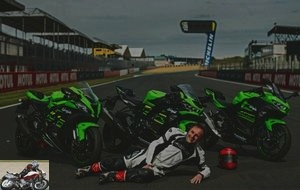 The budget will be a determining factor in the choice of its frame
The budget will be a determining factor in the choice of its frame
Ninja 400 highlights
- Ease
- The agility
- Homogeneity
- The price
Weak points Ninja 400
- The performances a little fair
- Not being able to get away with it with friends
Kawasaki Ninja 400 technical sheet
ZX-6R highlights
- The angry engine and not too hollow
- The very healthy part-cycle
- Accessible performances
Weak points ZX-6R
- Braking a bit just in endurance
- The shifter that doesn’t work on downshift (’is getting difficult!)
Kawasaki ZX-6R 636 technical sheet
ZX-10R highlights
- Affordable power
- Discreet and efficient assistance
- The finish and perceived quality
- The up & down shifter
Weak points ZX-10R
- The price
- The cost of use
Kawasaki ZX-10R technical sheet
K Days
K for Konviviales. On K days, we accept everyone, with or without Kawa. So you can come with friends, get away from it all, without distinction of brand. To perfect your knowledge, you can count on friendly and available instructors who will observe you and give you advice. The level groups allow you to ride in safety, "without fear and without reproach", in the middle of bikers who do not take the lead. In short, a beautiful and good experience and the opportunity to race on the legendary Le Mans track, a few days after the GP. Magic ! Count 155 € per day for a Kawa and 175 if you drive on another brand. Please note, there is only one day a year.
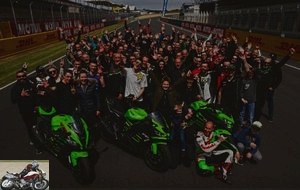 The K Days allow you to ride on the track, whether you are on a Kawasaki or any other brand
The K Days allow you to ride on the track, whether you are on a Kawasaki or any other brand
Related articles
-
Suzuki GSX-R 600 motorcycle test
Little Queen Revamped this year, the 600 GSXR follows in the footsteps of its big sister 750 cm3 from which it borrows the dress and even all the…
-
Roadster with Sugomi sauce or decarenated sports car A2 licenses have the choice between large bridles, sometimes very badly bridled, and smaller ones,…
-
Yamaha Thunderace 1000 YZF motorcycle test
Biker test: Jean-Michel I my name is Jean-Michel (JeanMi for close friends), from 42 but today in the 74 for professional reasons. I have 23 years old…
-
Kawasaki Ninja ZX-10R KRT motorcycle test
An integer character 4 cylinders in line, 998 cm3, 203 hp, 114.9 Nm, 206 kg all full facts, 18,099 euros. Nice surprise for me to find the Kawasaki…
-
Triumph Speed Triple 1200 RS motorcycle test
Madame More 3 cylinders in line, 1160 cm3, 180 hp at 10,750 rpm, 125 Nm at 9,000 rpm, 198 kg in running order, from € 17,500 Each time a new product is…
-
Ducati 848 motorcycle test – 134 horsepower in free version
The Ducati 848 is the mid-size sports car of the Italian brand, evolution of the 749, halfway between the 696 cm3 of a Monster and the 1198 cm3 of its…
-
Honda Varadero 1000 XLV motorcycle test
Maxi-Trail with a road vocation The Honda XL 1000 V Varadero, which appeared in 1998, is the heir to the famous Africa Twin … but the manufacturer has…
-
Yamaha Fazer FZ8 motorcycle test
Ho-mo-gene! (finally) Poor Yamaha FZ-8. When it arrived on the market in 2010, the new mid-size roadster from the tuning forks firm had all the assets…
-
Triumph Street Triple 765 RS motorcycle test
The Moto2 roadster 3-cylinder engine, 765 cc, 123 HP, 79 Nm, 166 kg dry, € 11,900 Since its release in 2007, the Street Triple has been a real commercial…
-
Kawasaki ZX6R 636 motorcycle test
The bomb The Kawasaki ZX-6R, which became ZX-6R 636 in 2001, has long been one of the most versatile sports cars in its category. In 2002, it has…
A rewarding little plague, well finished and attractive. Now put 4000 roros in there ……. the lunch’s are going to have to have good grades at school if they want mommy-daddy to invest in this brelon … KTM has got EVERYTHING (… marketing (business …) included)…
VVV … zouc …
This motorcycle also attracts young active people, who do not have a motorcycle license, wishing to move easily in urban areas and have THE look..
Seen another yesterday.
Very good CR, on the other hand I don’t understand, access to 125 licenses from 16 years old has been around for a while. I myself had passed it in 2001 and had bought a husqvarna SM. A nerf ball of more than 30hp ^^